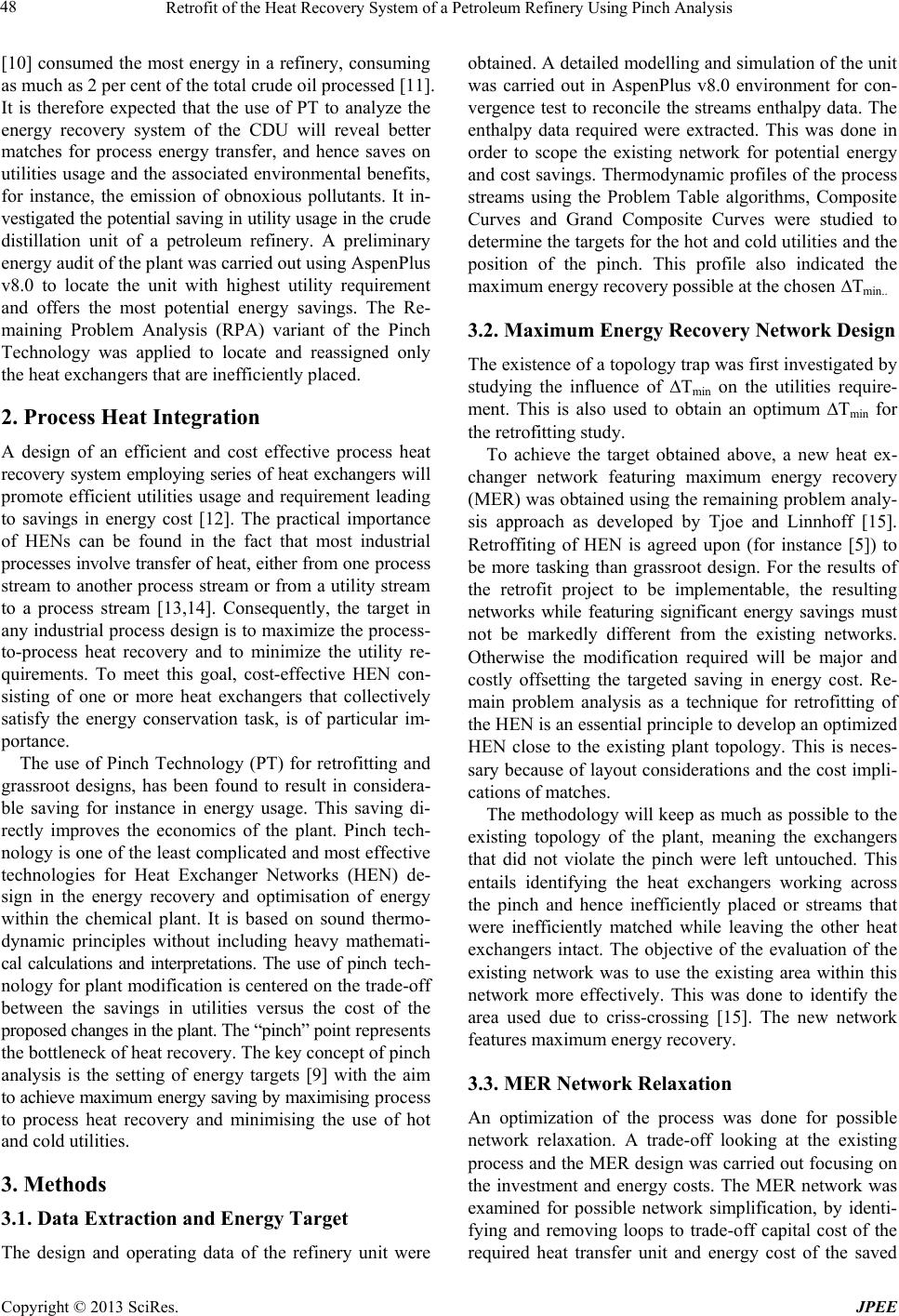
Retrofit of the Heat Recovery System of a Petroleum Refinery Using Pinch Analysis
Copyright © 2013 SciRes. JPEE
[10] consumed the most energy in a refinery, consuming
as much as 2 per cent of the total crude oil processed [11].
It is therefore expected that the use of PT to analyze the
energy recovery system of the CDU will reveal better
matches for process energy transfer, and hence saves on
utilities usage and the associated environmental benefits,
for instance, the emission of obnoxious pollutants. It in-
vestigated the potential saving in utility usage in the crude
distillation unit of a petroleum refinery. A preliminary
energy audit of the plant was carried out using AspenPlus
v8.0 to locate the unit with highest utility requirement
and offers the most potential energy savings. The Re-
maining Problem Analysis (RPA) variant of the Pinch
Technology was applied to locate and reassigned only
the heat exchangers that are inefficiently placed.
2. Process Heat Int eg ration
A design of an efficient and cost effective process heat
recovery system employing series of heat exchangers will
promote efficient utilities usage and requirement leading
to savings in energy cost [12]. The practical importance
of HENs can be found in the fact that most industrial
processes inv olve transfer of heat, either from one process
stream to another process stream or from a utility stream
to a process stream [13,14]. Consequently, the target in
any industrial process design is to maximize the process -
to-process heat recovery and to minimize the utility re-
quirements. To meet this goal, cost-effective HEN con-
sisting of one or more heat exchangers that collectively
satisfy the energy conservation task, is of particular im-
portance.
The use of Pinch Technology (PT) for retrofitting and
grassroot designs, has been found to result in considera-
ble saving for instance in energy usage. This saving di-
rectly improves the economics of the plant. Pinch tech-
nology is one of the least complicated and most effective
technologies for Heat Exchanger Networks (HEN) de-
sign in the energy recovery and optimisation of energy
within the chemical plant. It is based on sound thermo-
dynamic principles without including heavy mathemati-
cal calculations and interpretations. The use of pinch tech-
nology for plant modification is centered on the trade-off
between the savings in utilities versus the cost of the
prop osed c hanges in the plant . The “pinc h ” point represents
the bottleneck of heat recovery. The key concept of pinch
analysis is the setting of energy targets [9] with the aim
to achieve maximum energy saving by maximising process
to process heat recovery and minimising the use of hot
and cold utilities.
3. Methods
3.1. Data Extraction and Energy Target
The design and operating data of the refinery unit were
obtained. A detailed modelling and simulation of the unit
was carried out in AspenPlus v8.0 environment for con-
vergence test to reconcile the streams enthalpy data. The
enthalpy data required were extracted. This was done in
order to scope the existing network for potential energy
and cost savings. Thermodynamic profiles of the process
streams using the Problem Table algorithms, Composite
Curves and Grand Composite Curves were studied to
determine the targets for the hot and cold utilities and the
position of the pinch. This profile also indicated the
maximum energy recovery possible at the chosen ∆Tmin..
3.2. Maximum Energy Recovery Network Desig n
The existence of a topology trap was first investigated by
studying the influence of ∆Tmin on the utilities require-
ment. This is also used to obtain an optimum ∆Tmin for
the retrofitting study.
To achieve the target obtained above, a new heat ex-
changer network featuring maximum energy recovery
(MER) was obtained using the remaining problem analy-
sis approach as developed by Tjoe and Linnhoff [15].
Retroffiting of HEN is agreed upon (for instance [5]) to
be more tasking than grassroot design. For the results of
the retrofit project to be implementable, the resulting
networks while featuring significant energy savings must
not be markedly different from the existing networks.
Otherwise the modification required will be major and
costly offsetting the targeted saving in energy cost. Re-
main problem analysis as a technique for retrofitting of
the HEN is an essential principle to develop an optimized
HEN close to the existing plant topology. This is neces-
sary because of layout considerations and the cost impli-
cations of matches.
The methodology will keep as much as possible to the
existing topology of the plant, meaning the exchangers
that did not violate the pinch were left untouched. This
entails identifying the heat exchangers working across
the pinch and hence inefficiently placed or streams that
were inefficiently matched while leaving the other heat
exchangers intact. The objective of the evaluation of the
existing network was to use the existing area within this
network more effectively. This was done to identify the
area used due to criss-crossing [15]. The new network
features maximum energy recovery.
3.3. MER Network Relaxation
An optimization of the process was done for possible
network relaxation. A trade-off looking at the existing
process and the MER design was carried out focusing on
the investment and energy costs. The MER network was
examined for possible network simplification, by identi-
fying and removing loops to trade-off capital cost of the
required heat transfer unit and energy cost of the saved